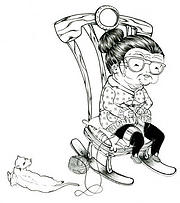The slow disappearance of Beijing’s hutongs
 When entering a Beijing hutong, it often feels more like the site of a temple fair. The narrow alleys are full of ringing bells from bicycles passing by, and all around there are hole-in-the-wall restaurants, fruit stands, tiny shops, snack vendors, barbers and peddlers of all sorts. It’s also common to see groups of elderly citizens playing mahjong or Chinese chess.
When entering a Beijing hutong, it often feels more like the site of a temple fair. The narrow alleys are full of ringing bells from bicycles passing by, and all around there are hole-in-the-wall restaurants, fruit stands, tiny shops, snack vendors, barbers and peddlers of all sorts. It’s also common to see groups of elderly citizens playing mahjong or Chinese chess.
For many local residents, hutongs are more than clusters of intricate lanes and courtyards. They record the memories of the rapidly disappearing lao Beijing lifestyle.
Because of the close-knit way hutongs are laid out, with many families sharing the old siheyuan courtyard houses, neighbors tend to have strong relationships and bonds between each other. They help each other take care of their children, make collaborative renovations to their shared space and celebrate festivals together.
Children who live in the same hutong normally know each other pretty well. Each day after school, they might get together to play games like marbles or cards for boys and jump-rope or house for girls. A most exciting time of the year would be when local performers of monkey and puppet shows would come to their hutong, announcing their arrival with loud cymbals.
 In contrast with the royal culture of the Forbidden City and Summer Palace, hutongs are part of a grass-roots Beijing culture. Their history can be traced back to the Yuan dynasty, when court dignitaries built their houses and courtyards arranged around a central well. “Hutong” originates from the Mongolian word “hottog,” which means “water well.” Most of the hutongs remaining in Beijing today date from the Ming and Qing dynasties. A few from the 13th century Yuan dynasty can still be found, however, such as Zhuāntǎ Hútòng (砖塔胡同) in the Xisi district on the west side of the city, widely regarded as Beijing’s oldest hutong.
In contrast with the royal culture of the Forbidden City and Summer Palace, hutongs are part of a grass-roots Beijing culture. Their history can be traced back to the Yuan dynasty, when court dignitaries built their houses and courtyards arranged around a central well. “Hutong” originates from the Mongolian word “hottog,” which means “water well.” Most of the hutongs remaining in Beijing today date from the Ming and Qing dynasties. A few from the 13th century Yuan dynasty can still be found, however, such as Zhuāntǎ Hútòng (砖塔胡同) in the Xisi district on the west side of the city, widely regarded as Beijing’s oldest hutong.
When it comes to the names of hutongs, they seem to contain a bit of everything. They can be in reference to the shape of the hutong, like hézi (盒子), which means “box,” or zhúgān (竹杆), which means “bamboo stick.” They might be named after a particular area like Dashilan’r, Xidan or Sanlihe; or they can be named after plants or trees, like Liǔshù (willow) Hútòng (柳树胡同). Some hutongs are named after nearby landmarks, like markets or temples, or after the names of famous locals.
Beijing’s hutongs have also been home to many famous historic figures. Yan Song, a minister of the Ming dynasty, lived in Chéngxiàng Hútòng (丞相胡同). China’s last empress, Wan Rong, was born in Mào’er Hútòng (帽儿胡同). The playwright Lao She wrote many stories related to his upbringing in a hutong. And the former hutong home of Song Qingling, Madame Sun Yat-sen, is now a museum in the trendy area of Houhai.
With the modernizing of the city, the number of traditional hutongs are becoming fewer and fewer each year. Soon these beautiful structures and the way of life they supported will be gone and replaced by modern high-rises, and the next generation of children will have to find new streets and places to play.



